Dell Inspiron One 2320: Stuck in the Middle With You
by Dustin Sklavos on November 17, 2011 12:30 AM ESTGaming Performance
I can only hope I've contained my excitement enough for this part. As mentioned in the frequently referenced HP TouchSmart 610 review, these GPUs just aren't powerful enough to be driving these 1080p displays. The NVIDIA GeForce GT 525M is pretty heavily hamstrung, operating at even lower clocks than the already underpowered desktop GT 430. I can't believe this is the best Dell can offer in this all-in-one. We'll start with our "Medium" 1080p test suite. It'll be a little underwhelming with just the two all-in-ones tested here, but bear with me.

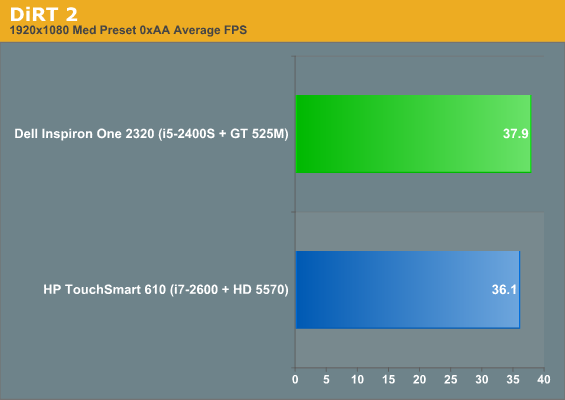
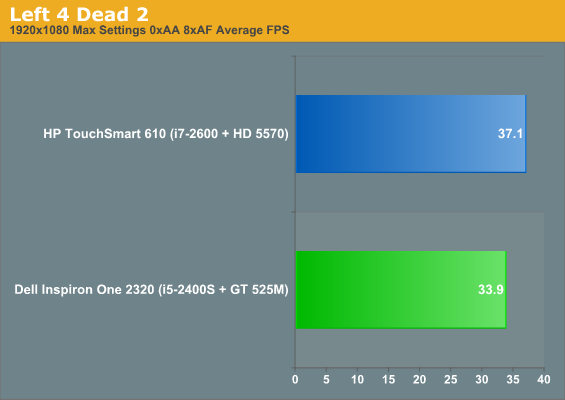
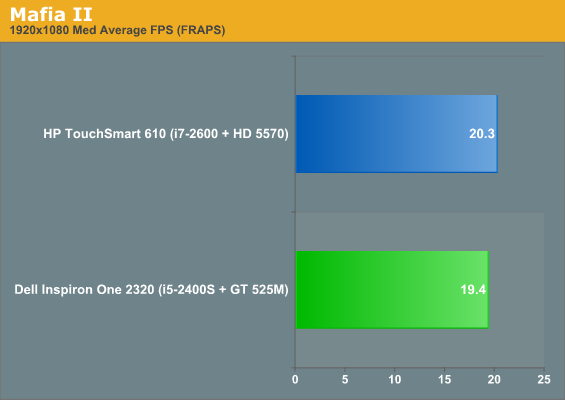
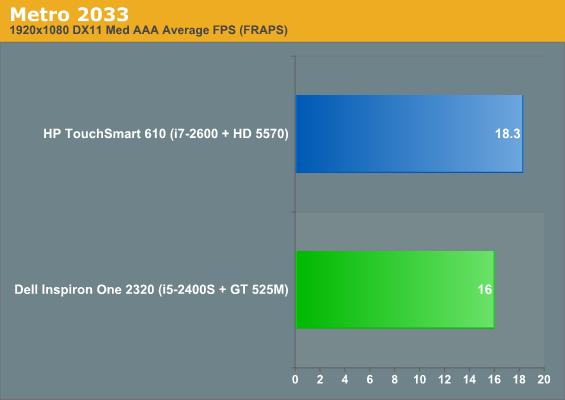
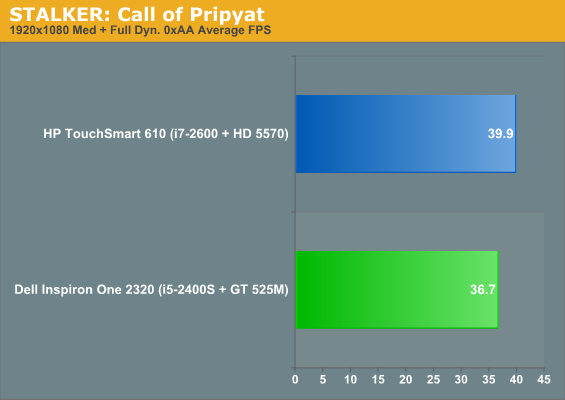
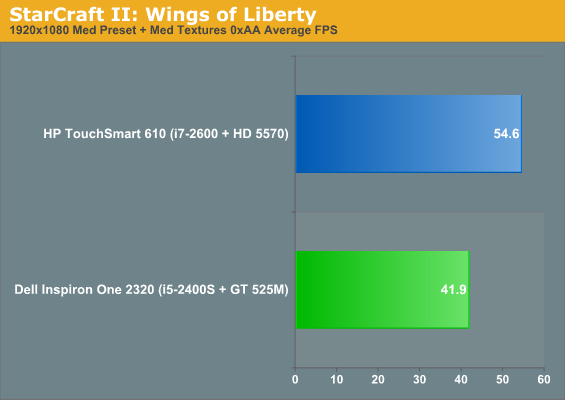
Medium is about as good as you're going to get for half of these games if you want to try and play them at native, but the Inspiron One 2320's GPU is sadly even weaker than the already mediocre AMD Radeon HD 5570 in the TouchSmart. It leads in DiRT 2 but trails everywhere else, and the "High" testing is only more depressing.
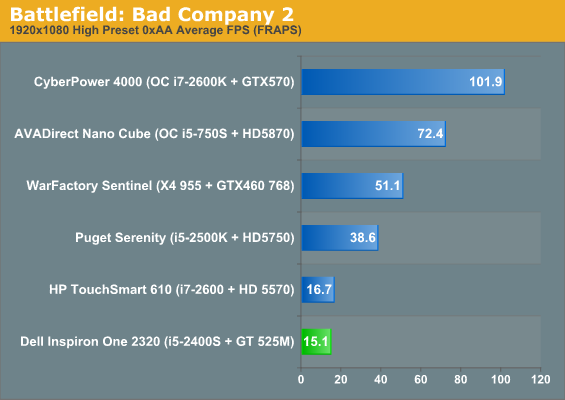
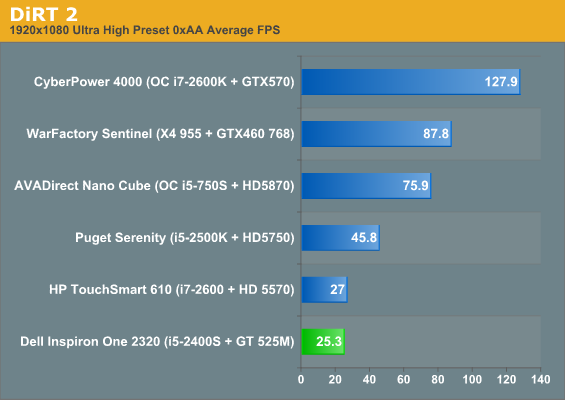

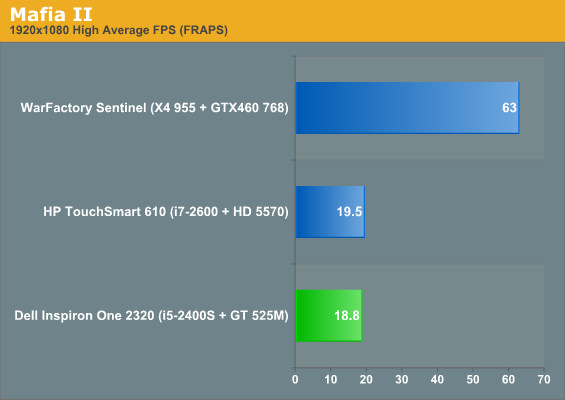
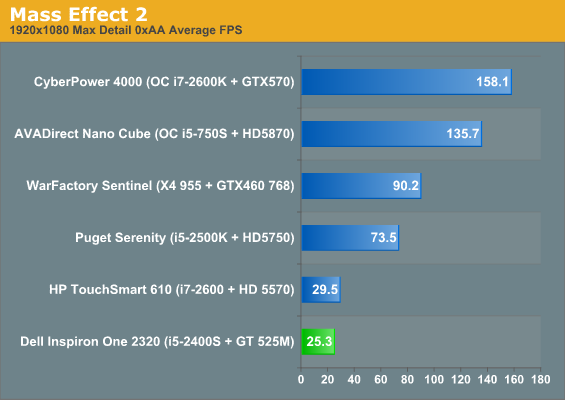

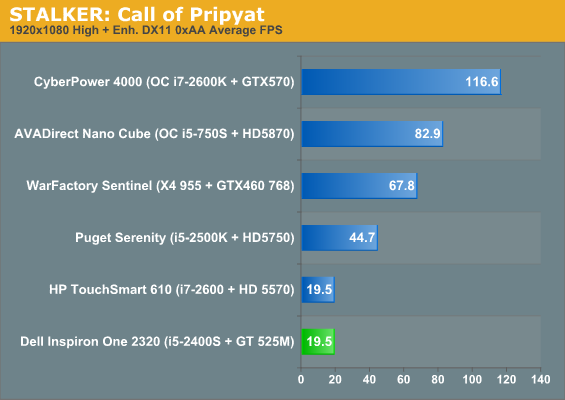
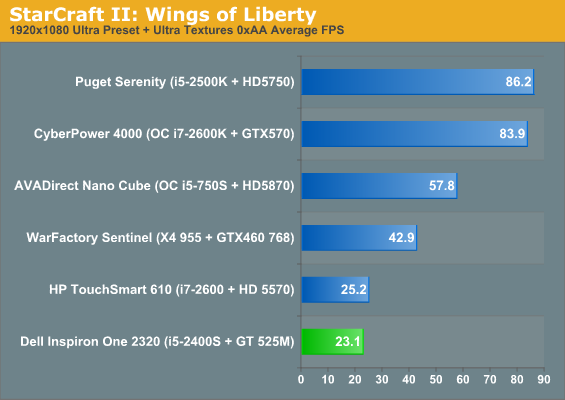
At our high settings the games are unplayable across the board. All-in-ones need something at least at the level of a Radeon HD 5750 to really support the resolutions they're shipping at. And keep in mind that our gaming test suite is mostly over a year old, so newer titles will likely struggle even more (e.g. Battlefield 3, Batman: Arkham City, Skyrim, Deus Ex: Human Revolution, Rage, and the slew of additional games coming out this holiday season).
I asked a friend of mine who's a big fan of StarCraft II to give playing it on the touchscreen a try. As some of you have observed, I'm honestly too much of a moron to grok RTS games, but my buddy Benjamin is a big fan so I turned him loose on the Inspiron One 2320. His response was that the potential for a touch interface in the game was definitely there, but the game's not really designed for it and would need some changes to be playable that way. There are also the issues inherent with responsiveness in current touchscreen technology (misregistered clicks, etc.) that keep it from being a home run. I do feel like this genre of games is one of the places where a touchscreen might be viable on the desktop, but it seems to be a bit of a chicken-and-egg situation at present, and without decent graphics hardware I'm not sure it can ever really succeed.










35 Comments
View All Comments
shmmy - Thursday, November 17, 2011 - link
I sell these style computers at a major big box retailer and I just don't get it.This article is like a car review where you take a economy car and put it around a race track then complain that its too slow. (all be it an expensive economy car but still an economy car)
Yes this spacific machine is a beast of an AIO, the store I work at has nothing like this almost all of them are sub 1k. The area I work in has an average income of 80-90k a year so its not that people are cheap. 90% of the people who buy these types of computers will never even open a real game.
Maybe in a year or two when the power levels go down on all the new hardware these things will be better but now its a fun toy with a touch screen.
A realistic test that can be done for this machine is to see how fast it gets to Facebook and porn because thats all that these types of computers are used for. :)
Dustin Sklavos - Thursday, November 17, 2011 - link
I used to work retail, and more people play games than you think. Also, sometimes someone doesn't play games, then sees something they like and they want to play it too. And then their computer sucks for it. I have also seen this happen.Our testbed is standardized for a reason but beyond that, this computer is ill balanced and the hardware runs way, WAY too hot. I do have a less expensive Toshiba all-in-one I'm putting through its paces right now, but frankly I still have issues with touchscreen all-in-ones in general as I've mentioned. The technology is very much still in its teething stage.
orgy08 - Thursday, November 17, 2011 - link
I tend to agree with you. My wife loves using all in one PCs and her ageing HP Touch-smart isn't holding up to well with the last World of Warcraft expansion. I'll probably end up building a slim/mini desktop instead of getting another All in one with low end graphics. Go ahead and sell to your target audience, but leave the option open to at least customize the PC online with faster components.brybir - Thursday, November 17, 2011 - link
I agree with you.Statements like "What we really need for 1080p AIO systems is at least GT 555M or (preferably) GTX 560M level hardware; we've seen such chips in 14" and 15" notebooks; would it really be that hard to stuff something faster into a significantly larger AIO system?"
Sure, throw in a 560M and we can all pay an extra $50 or $100 dollars for the computer, or throw in a beefier processor for an extra $50, then why not add an IPS display for another $100....
You can see where this is going with this. The person you talked with at HP also explained that same concept....they have a target market and a price range for that target market in order to be competitive. This device is NOT designed for the high end of the market or for those that want to play games and stuff.
The author states in a post below that he knows that some people will buy this later and want to play games, or that the computer is not "balanced" because the specs are not all at least mid-level gaming PC specs, but that misses the point of market segmentation and making tradeoffs to reach a price point. The only value I find in those type of comments are when you can say "check out item A and B, both same type of device at the same or very similar price, but item B has much better overall specifications and capabilities" etc. Just making statements that the system is not balanced or that it does not cater to all possible uses is just not useful in a review like this.
JarredWalton - Thursday, November 17, 2011 - link
Here's the fundamental problem with an all-in-one: you can't really upgrade most components. If you decide you don't like the display, want a faster GPU or CPU, or want more storage (e.g. SSD + HDD), in most cases your only recourse is to buy a new system. A laptop is portable and thus stuffing in higher end GPUs isn't always desirable; for an AIO, you really should get something a little more forward looking than a bare minimum GPU offering.If the GT 525M is enough, then you probably don't need the discrete GPU at all. Dell offers that as well, but have you looked at the pricing? It's a bit ridiculous for what you're getting, and it's time to go back to the drawing board. As we point out, the HP has a significantly better display, a better stand, a faster CPU, a better GPU, and it runs cooler; under load it even uses less power than this. For $150 more, the $1400 HP TouchSmart would be a far better buy.
If Dell wants to make a cheap AIO, then make a cheap AIO; if they want something that can scale up to $1400, they need more than just an upgraded budget AIO to satisfy. That's one of the issues I have had with notebooks where the base model starts at $500. Right then you know it has cheap build quality and a crappy display, and if you upgrade to a high-end $1500 configuration you'll still have the lousy build quality. The cooling on the Inspiron 2320 shows that it's not capable of handling higher spec GPUs, and yet it can handle the i7-2600S. Doesn't that strike you as unbalanced?
Given the size of an AIO relative to a notebook, it should be trivial to give the GPU its own dedicated cooling solution. Then instead of $300 to add 2GB RAM, double the HDD to 2TB, and adding the GT 525M, we could get a meaningful upgrade. Given the 2GB RAM upgrade is practically free, and even the HDD upgrade only costs $50 (and that's with hugely inflated HDD pricing right now), you're pretty much spending $250 for the GT 525M. And yet you're complaining that we suggest a faster GPU would be wise. Really, Dell should have tweaked the design and just shoved in a desktop GTX 550 Ti (or similar hardware). Instead, the aesthetic appearance (which I don't particularly care for to begin with) takes priority and we end up with a rather noisy under load system that runs too hot and underperforms.
JWade - Thursday, November 17, 2011 - link
My wife has the AMD version of this, hers is very much upgradeable, better processor can be installed (she currently has a quad core AMD, had a base of a dual core), the video can be upgraded, it takes mxm type, just like alot of laptops do, ram can be upgrades as well as the hard drive. were these options available from Dell? well the processor upgrade was, but the rest no, but they still can be done.JarredWalton - Thursday, November 17, 2011 - link
Technically, yes, you can upgrade the CPU and you can swap out the HDD, but upgrading the GPU is a craps shoot at best. Upgrading MXM modules is not something to be done lightly. It looks like, based on the current GPU offerings, the Inspiron One 2320 is capable of supporting 35W TDP GPUs. Assuming the BIOS supports the GPU you want to put in (which isn't guaranteed), if you tried to put in a 75W TDP MXM GPU in place of the current GPU, you'd almost certainly overheat at best, and cause the system to fry itself at worst.brybir - Thursday, November 17, 2011 - link
But again, your comments fall back into my original statements. You can't upgrade the computer as easily, but not everyone wants or needs a computer that can be easily upgraded, if at all. They buy computers like the Dell in this article for other reasons...otherwise, if upgrading was a big priority, they would not have bought this Dell in the first place...I don't disagree with you on your points regarding GT525M vs. Intel graphics, cheap scaling etc of components, but again you come back to the system not being balanced, as if the GPU must match the capabilities of the CPU that it is paired with so that it can handle a wider range of usage scenarios. Dell engineered this thing with certain ideas of who it was being marketed to at a certain price point, and what would consumers of this device at this price point like to do with the computer. They base their decisions off this information. Sometimes they are right, sometimes they are wrong. But the idea that a system MUST be balanced among its various components at all times regardless of the targeted use profile seems to go against the entire idea of how PCs, and most consumer items, are designed and marketed.
Finally, your last paragraph strikes me as somewhat....assumptive. You don't know whether it is actually trivial for Dell to re-engineer an entire product line or what the true costs of doing such are. There are hundreds of variables to consider when engaging in mass manufacturing that go well beyond "it should be easy" or "look...it would have been so easy to just do that" when it is never, ever, that simple. Further, you do not know what Dell pays for parts (or maybe you do, but I doubt it) what their internal goals were when developing this product line were, what margins they were shooting for etc.
But I think you somewhat validate my point when you talk about the HP competitor. You stated that for $150 I can get more CPU power, a better GPU, a better display, a better stand, it runs both cooler and uses less power. If I were buying one of these, I would probably spend the extra $150 and buy the HP, and that is an entirely relevant criticism. But, what if I don't have the extra $150 to spend...do I just go without, or do I decide I would rather have at least what the Dell offers in my price range? Or what if I bought it because the only thing I wanted to do was type Word documents and stream Netflix. Is paying $150 extra to accomplish those tasks worth it? I get no benefit from the CPU or GPU upgrade in that case, so then the question is whether the display/power/heat issue worth $150 extra dollars, to which the answer will be different for everyone.
My last point is that some of these articles have gotten a little bit preachy and seem to always compare things against "what could or should have been". I mean, the author actually states "What we really need for 1080p AIO systems is at least GT 555M or (preferably) GTX 560M level hardware". All I can say is that the AUTHOR thinks that we all need this, that we should all pay for it, and that no AIO should ever not have at least this level of capability." These sort of statements just strike me as nearly philosphical in nature. As noted above, it assumes we all need that hardware, which is not true, and then you provided a number of statements attempting to justify it by talking about all the hardware changes that COULD have been made and the redesign and reengineering to allow that to happen with a small cost increase. But that goes into the issue above about assumptions.
Anyways, I do enjoy the articles generally, but sometimes I think you guys get a little to thick into the "everyone needs this" and then making huge assumptive jumps justifying why or how that could be achieved. That gets a bit tiring to read when it is article after article.
Death666Angel - Thursday, November 17, 2011 - link
Your complaints would make sense, if we were talking about a company that offers only one configuration. But Dells business model is the configurability of all their products. It wouldn't hurt Joe "non gamer" Average if they at least offered better graphics, right?JarredWalton - Thursday, November 17, 2011 - link
Brybir, you're missing the point. For $600, the Inspiron 2320 makes a lot of sense -- though at that point I'm not sure the Celeron CPU would be fast enough. The reviewed configuration costs twice as much, but it's still a $600 chassis with a few performance upgrades, and the GPU upgrade is questionable at best. Perhaps a better way of stating it is that Dell should either go with the IGP (which they do on lower end configs) or put in a "real" GPU; the GT 525M is barely adequate for 1366x768 gaming, and if you're not gaming there's not a whole hell of a lot of need for the dGPU. Netflix streaming works fine without the GT 525M, and Word runs fine on an old Core 2 Duo with GMA 4500 graphics.My point about the overall design is that if you're going to make a system that is supposed to meet the needs of $600 AIO and $1500 AIO buyers, you need to consider BOTH markets and what they want. Apple takes good care of their $1200+ AIO customers in delivering a lot of performance and generally meaningful upgrades, and this Dell system doesn't at least match Apple. The base model $1200 iMac has a slightly smaller LCD, but it has better build quality, a much higher quality LCD, a faster GPU, a faster CPU, and more connectivity.
Looking at the $1250 model (reviewed here), the Inspiron One falls short of the 21.5" iMac in every meaningful area. Drop to the $950 model and all you can really say is that it's cheaper, and at $600, it's a budget AIO and you get exactly what you pay for. None of the builds currently available are worth recommending in my opinion, or in Dustin's, and that's what we do here: we show benchmark results, we discuss the bigger picture, and we come to a conclusion on whether a product is worth buying or not. The Inspiron One isn't undesirable because of the GT 525M; it's a poor design because the low end model is underwhelming and the expensive model is even more so.